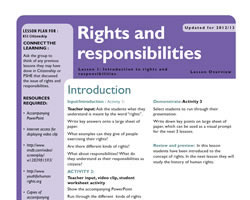New to Safeguarding Essentials?
Subscribe Now
|
Existing members
Sign in
here
Citizenship Lesson Plans / KS3 - Rights and Responsibilities - 4 lessons / Rights and Responsibilities Lesson Plan 1 - Introduction
There are 2 Documents available to download for
Rights and Responsibilities Lesson Plan 1 - Introduction
Students watch video clips about human rights, and use case studies to introduce them to basic concepts.

- TRS Citizenship Rights Lesson 1 PDF Downloads = 129
- TRS Citizenship Rights Lesson 1 PPT Downloads = 101
Connect the Learning
Ask the group to think of any previous lessons they may have done in Citizenship or PSHE that discussed the issue of rights and responsibilities.The Big Picture
The curriculum aims for the PSHE: Personal Wellbeing programme of study include young people becoming “responsible citizens who make a positive contribution to society.”
The Citizenship programme of study at KS3 requires students to learn about “…their rights, responsibilities, duties and freedoms…” The Every Child Matters aim that is most relevant here is “make a positive contribution”.
The Learning Outcomes
From the KS3 Citizenship programme of study:1.2
a. Exploring different kinds of rights and obligations and how these affect both individuals and communities.
b. Understanding that individuals, organizations and governments have responsibilities to ensure that rights are balanced, supported and protected.
c. Investigating ways in which rights can compete and conflict, and understanding that hard decisions have to be made to try and balance these.
Input/Introduction
Activity 1: Teacher input
Ask the students what they understand is meant by the word “rights”. Write key answers onto a large sheet of paper. What examples can they give of people exercising their rights? Are there different kinds of rights? What about responsibilities? What do they understand as their responsibilities as citizens?

